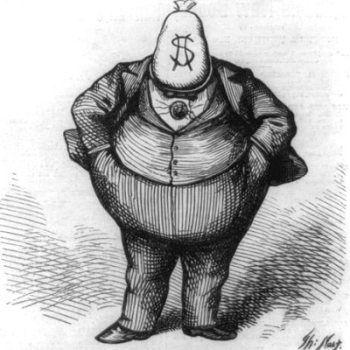Ali Breland presents a fine history lesson for Mother Jones, “Why Are Right-Wing Conspiracies so Obsessed With Pedophilia?”
Breland notes, correctly, that Trump-era right-wing conspiracy theories like PizzaGate and QAnon are just recycled variations of the same Satanic Panic that produced the McMartin Preschool hysteria in the 1980s. He traces this same wild story deeper into history — to the witch trials of Europe and New England and to the vile Christian “blood libel” against Jews.
As all of those examples show, the obsessive theme here is not merely pedophilia. That sexual abuse, in these conspiracy stories, is always prelude to ritual murder and cannibalism. Satanic baby-killers, in other words. It’s always Satanic baby-killers.

Breland’s piece is a fine survey of the topic, and he’s done his homework — reading and consulting with many of the scholars who’ve been trying to make sense of this stuff.* And his concluding example of the long history of Satanic baby-killerism is great fun:
“Decay of morals grows from day to day,” goes one despairing account. A secret cabal is wreaking havoc across the land, the man complains to his friend. Its members “recognize one another by secret signs and marks,” and “everywhere they introduce a kind of religion of lust” that subverts “ordinary fornication.” There is a rumor that they worship the “private parts of their director and high priest.” Maybe the rumor is false, “but such suspicions naturally attach to their secret and nocturnal rites.”
In this dialogue, written by Marcus Minucius Felix in the 2nd century, the Roman pagan Caecilius Natalis speaks of Christians the way Pizzagaters described John Podesta and his fellow liberal elite. Natalis is particularly incensed by the cult’s initiation ritual. The details are as “revolting as they are notorious”: New members are initiated into the cult, he reports, by stabbing and killing an infant who has been coated in dough.
But Breland’s excellent article also left me with the same frustration I had with Mike Hertenstein and Jon Trott’s also excellent book on best-selling evangelical author and joke-thief Mike Warnke, Selling Satan. Their debunking of Warnke’s lies is thorough, clear-eyed, and devastating, but Warnke himself is ultimately not as interesting as the large audience that cheerfully made him a very wealthy man. Warnke was just a predatory con-artist who had figured out how to make a ton of money selling lies. Such people always exist, and whether they’re grifters seeking money, or demagogues seeking political power, or nihilists seeking “lulz” they’re all just opportunists taking advantage of the same very strange and very disturbing fact: millions of people want their lies to be true.
I’m not sure it’s ever 100-percent accurate to say that the audience for these conspiracy stories “believes” them. There’s too much will and choice and volition involved — too many outrageous-yet-unexplored claims, too many transparent falsehoods and obvious inconsistencies they refuse to allow themselves to acknowledge. People like Warnke and Thomas of Monmouth and Lawrence Pazder and Léo Taxil may have acted like grifters fleecing the suckers, but they only succeeded because those suckers wanted to be fleeced. Because their audience desperately and eagerly wanted to believe in a vast conspiracy of Satanic baby-killers.
Some will always object that this is too cynical and uncharitable a view of that audience, but this is something that can easily be confirmed. It is something that has repeatedly been confirmed. Because all of these conspiracy stories have been debunked and every time that happens, this audience responds the same way: passionate anger, resentment, and the kind of crushing disappointment we only see when someone’s greatest hopes and dreams are denied them. They make it very clear, every time, that they do not wish to live in a world without a vast conspiracy of Other People who sexually abuse, then ritualistically murder and consume infants.
Breland addresses this desire in his piece, mostly attributing it to anxiety. Thus:
Beck likens conspiracy theories to parables. The ones that stick are those that most effectively validate a group’s anxieties, with blame assigned to outsiders. In a 2017 paper on Pizzagate and pedophile conspiracies, psychology professor Jim Kline, now at Northern Marianas College, argues that conspiracy theories “are born during times of turmoil and uncertainty.” In an interview, Kline goes further: “Social turmoil can overwhelm critical thinking. It makes us get beyond what is logically possible. We go into this state of hysteria and we let that overwhelm ourselves.”
And:
With Pizzagate and QAnon, the molesters have changed from day-care workers to the liberal elite, and the politics behind the theories now are more explicitly spelled out. But the general context is more or less the same: conservative retrenchment after a period of progressive social gains. If women’s entry into the workplace in the latter half of the 20th century triggered deep anxieties about the decay of traditional gender roles and the family unit, in the 21st century it was same-sex marriage, growing acceptance of transgender rights, and the seeming cultural hegemony of a social justice agenda. “Q found that fear,” says Travis View, a conspiracy theory researcher and a host of the QAnon Anonymouspodcast.
… View points out that the concern about elites preying on children isn’t baseless, either. “The core of elements of the systematic elite child abuse theories — they aren’t crazy,” he says. “There are instances of wealthy powerful abusing children and other people covering it up. Jeffrey Epstein, the Catholic church. People have the sense that elites can commit horrifying crimes and get away with them.”
That’s correct, but it’s only the first piece of the puzzle. The appalling revelation of generations of abuse and cover-up by the Catholic church might buttress belief in “systematic elite child abuse theories,” but it still cannot account for the triumphant glee that Satanic baby-killer “believers” demonstrate in response to such revelations. It doesn’t explain why their emotional reaction to such stories is, “Yes! At last! Excellent!”
Nor does it explain why Satanic baby-killer devotees have turned out to be the staunchest defenders of the church in the wake of such revelations, rejecting and denying all of the allegations and the guilty verdicts because, in their view, this is an assault on the church orchestrated by the real elite systematic child-abusers — the Satanic baby-killers of Planned Parenthood, the ACLU, the NAACP, etc.
Anxiety, as Reinhold Niebuhr understood, is “the internal precondition of sin,” but not the sin itself. It can be the “state of temptation,” but it is neither the effect nor the result of that temptation. What it tempts us toward, Niebuhr said, was pride. Anxiety presents us with the opportunity to choose the sin of pride, but it is not the cause of that choice. I think the sin, and the act of choosing it, and the cause of that choosing, are all that same pride.
Because it’s not quite accurate to say that Satanic baby-killer enthusiasts really want and desire the existence of real monsters. That’s what they’re clamoring for. It’s the fantasy role-playing game they’ve all agreed to play together. But the counterfeit joy they find in that fantasy doesn’t come from the monsters, it comes from the NPCs. It comes from the sense that their knowledge of this secret conspiracy of monsters, and their fantasy of bravely opposing it, makes them special.
The fantasy isn’t so much that there are real monsters, or a real conspiracy of Satanic baby-killers conducting its rituals underneath the neighborhood pizza shop or Masonic lodge or public school. The fantasy is that if there were, then they — and they alone — would be the ones to rise up against it. They would prove to be braver, more virtuous, and more heroic than all their otherwise indistinguishable-from-them neighbors. The fantasy is that we are better than all those sheeple who just don’t or wouldn’t even care that sweet, innocent little babies were being perversely tormented, then killed, then eaten, by a nefarious cult that secretly walks among us.
The anxiety is not primarily about “social turmoil” or “conservative retrenchment.” (The Satanic Panic of the 1980s, after all, accompanied the triumphant rise of Reaganism.) It is, rather, the same anxiety Max Weber identified as the root of the “Protestant work ethic” — the anxiety that we may be damned because we are damnable, because we are no damn good. The pursuit of the material blessings Weber saw as an attempt to mollify that anxiety by providing evidence of divine blessing is not really an option for most people (if it ever was). So how can we reassure ourselves that we will be among the tiny sliver of those who might escape eternal damnation? How can we reassure ourselves that we will be counted among the sheep rather than among the goats?
Well, that story of sheep and goats provides one answer. But it’s hard. Too hard. Too hard to achieve and too hard a teaching to accept. And if becoming better seems too hard, then the next best thing would seem to be becoming better than.
Alas, even better than proves more difficult than we can manage. That’s true in the small, mundane details of our daily lives, which a few signals and totems of distinctive piety can’t convince even ourselves really set us apart from the vast majority of our neighbors. And it seems especially true of the big things — the grand sweep of history in which we find ourselves, like our ancestors before us, taking part in the shedding of blood of the prophets.
That last bit — see Matthew 23:29-35 — is where “social turmoil” and “conservative revanchism” fit into this. The anxiety doesn’t arise simply because social change or progress toward greater justice and equality are occurring. The anxiety arises because we had so long resisted and prevented and opposed such change that its flowering, however tenuous, reminds us that we are neither good enough nor better than.
Faced with this internal precondition of sin, we retreat into the prideful fantasy of Satanic baby-killerism. We retreat from a world filled with real evils, real monsters, and real injustices and narcotize ourselves from the anxious recognition that we’re a part of that by half convince ourselves that we are, instead, the heroic remnant bravely standing against an imaginary conspiracy of superlatively evil neighbors.
And now we’ve managed to reach the end of this post without ever using the words “segregation” or “civil rights” or “anti-abortion,” and so maybe you might think this was not a discussion of how anti-abortion politics and religion arose among those who were the fiercest defenders of segregation and the fiercest opponents of civil rights and that it’s really only an abstract discussion of the persistent history of a particularly nasty strain of folklore and not an examination of how anti-abortionism as politics and religion exists primarily to convince opponents of greater justice and equality that they can continue that opposition and still imagine themselves to be better than their neighbors. But please don’t think that.
– – – – – – – – – – – –
* Two of those scholars are the writer Richard Beck and the historian Philip Jenkins — both of whom, I should clarify, are different people than the writer Richard Beck and historian Philip Jenkins we often interact with here. I’m pretty sure, however, that both of those Philips Jenkins would enjoy sitting down together for a long chat about their respective interests, and that I would enjoy sitting down with them to listen.












